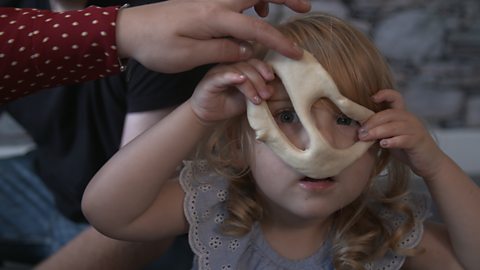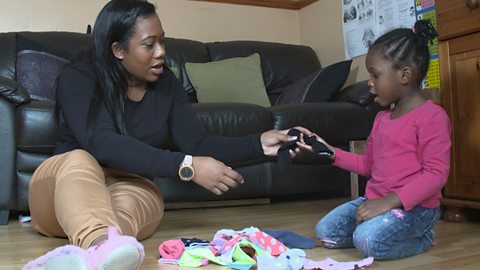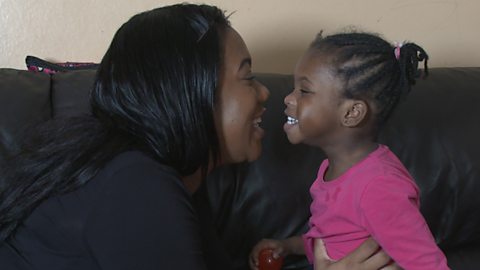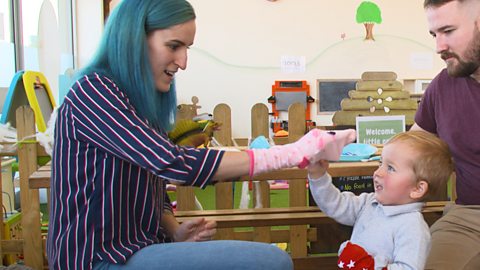Home > Activities > 2-3 years
Making homemade playdough is a fun way for your child to explore their creativity and learn new words. Why not give it a go?
You can make playdough in next to no time from everyday ingredients found in your kitchen cupboards. We've included our homemade playdough recipe below.
Our short video has loads of advice on how to make the most of your playdough playtime.
I'm playing with the play dough, yep!
Ha ha!
Oh, these messy hands.
Look at these messy hands!
Is it sticky, Gracie?
It's stuck on my finger.
Made a shape!
What shape is it?
Circle.
Good girl.
Woah.
Get all the lumps out!
Get all the lumps out, good girl.
Good girl.
Squish, squish, squish. Splat it!
Ahh, splat! Woah, flying!
I'm making a sausage.
You're making a sausage?
Can daddy make a ball?
Ooh… Ah! I want to pull it!
Go on, then, you pull it.
Oh! Ha ha!
Can you squash it on the tray, Gracie?
Ahh, what can you do with the modelling clay?
Look, it's like eyes.
Why is playdough a good toy?
- Playing with playdough together improves language and social skills.
- Using hands to mould the dough develops fine motor skills.
- Sensory play boosts brain development and builds brain connections.
- Choosing what to build helps children learn to problem-solve.
- Letting your child lead boosts confidence in play.
How to make own playdough
Our great playdough recipe is simple to make, will only take a few minutes and will keep for a long time.
For one playdough ball, mix together:
- 8 tbsp plain flour
- 2 tbsp table salt
- 60ml warm water
- 1 tbsp vegetable oil
- food colouring (optional)
You can store your playdough in a plastic sandwich bag in the fridge to keep it fresh.
Don't forget to squeeze the air out from the bag.

List of playdough activities and ideas
There are tonnes of opportunities to chat and develop language skills while you're playing with homemade playdough.
Ask your children to describe what they're doing while they play and how it feels. This is a great opportunity to introduce new words like "squishy", "sticky" and "gloopy".
If you added food colouring to your playdough, you can also talk about the different colours and help your child build these descriptive words into sentences.
Why not try telling a story together with objects you have made, or have a race to build the tallest tower?
Letting your child lead on this will be great for their confidence and their language learning, as they have to plan, think and problem-solve to reach their end goal.
There are loads of sensory benefits when playing with play dough. When kids use more than one of their senses during play, it can help their brain learn words more quickly.
Sensory play also helps your little one’s attention span. When a child plays with something hands-on, they might stay engaged with it for longer than if they just listened to spoken words.
Building strength in the muscles of the hands through activities like moulding, rolling and squishing helps prepare them for tasks like holding a pencil or scissors when they're older.
Playdough is a great way to introduce the concept of counting, shapes, descriptions, and more. All of these are a great basis for their first English and maths lessons when they start school.

What age is playdough suitable for?
Our homemade playdough recipe is intended for children aged two years old and up.
Is playdough edible?
Our playdough recipe is made with edible ingredients, so it is safe if children consume some during play. We know how some children like to explore the world with their mouths!
We wouldn't encourage children to eat the playdough however, as it contains a good amount of salt.
More sensory play activities for young children
There are loads of benefits of sensory play for young children. If you're not in the mood for playdough today, why not try one of these?
- Painting with tea bags is another cheap activity that provides hours of fun.
- Finger painting is worth a try if you're willing to get a bit messy
- Find out what sensory play is and why it's great for babies and toddlers.






